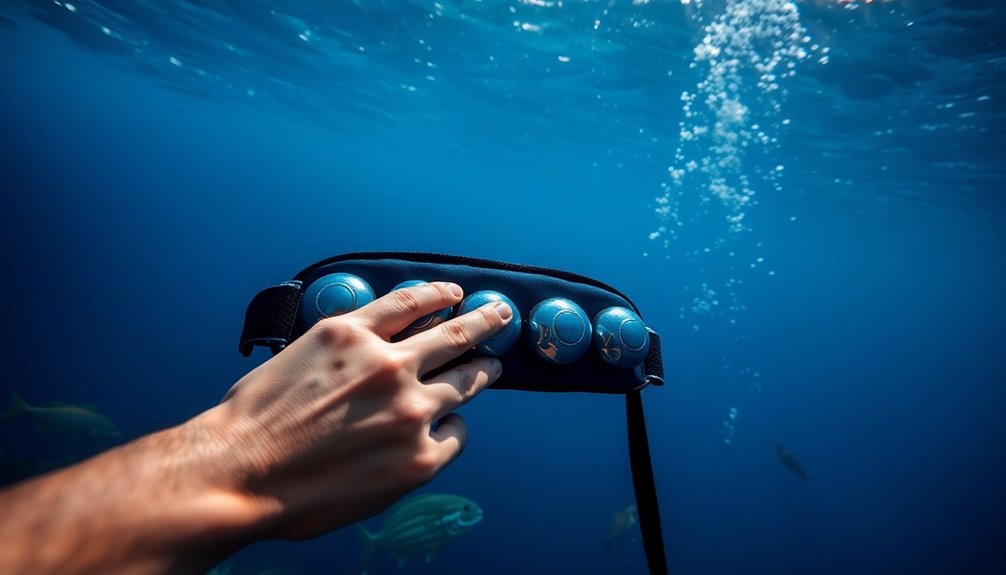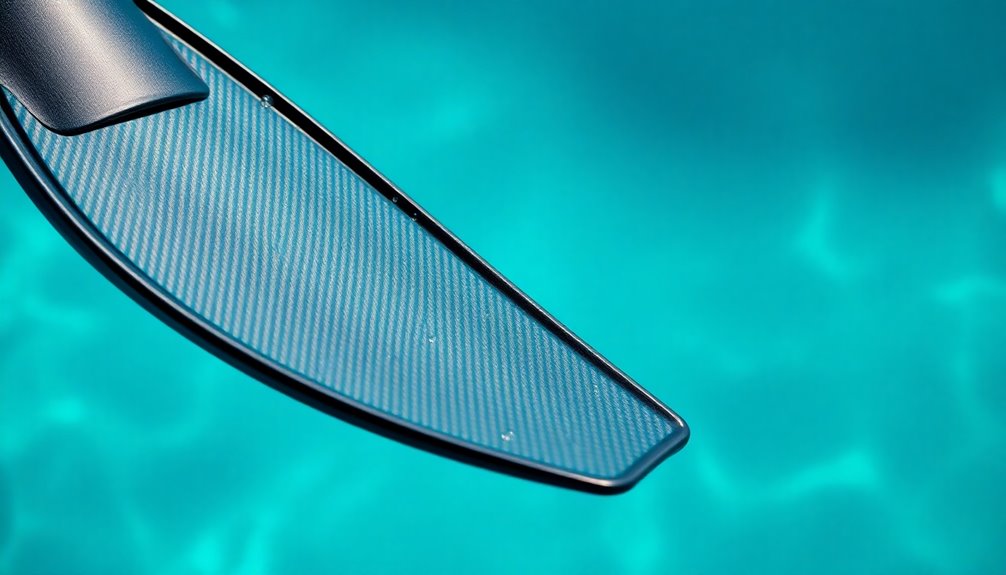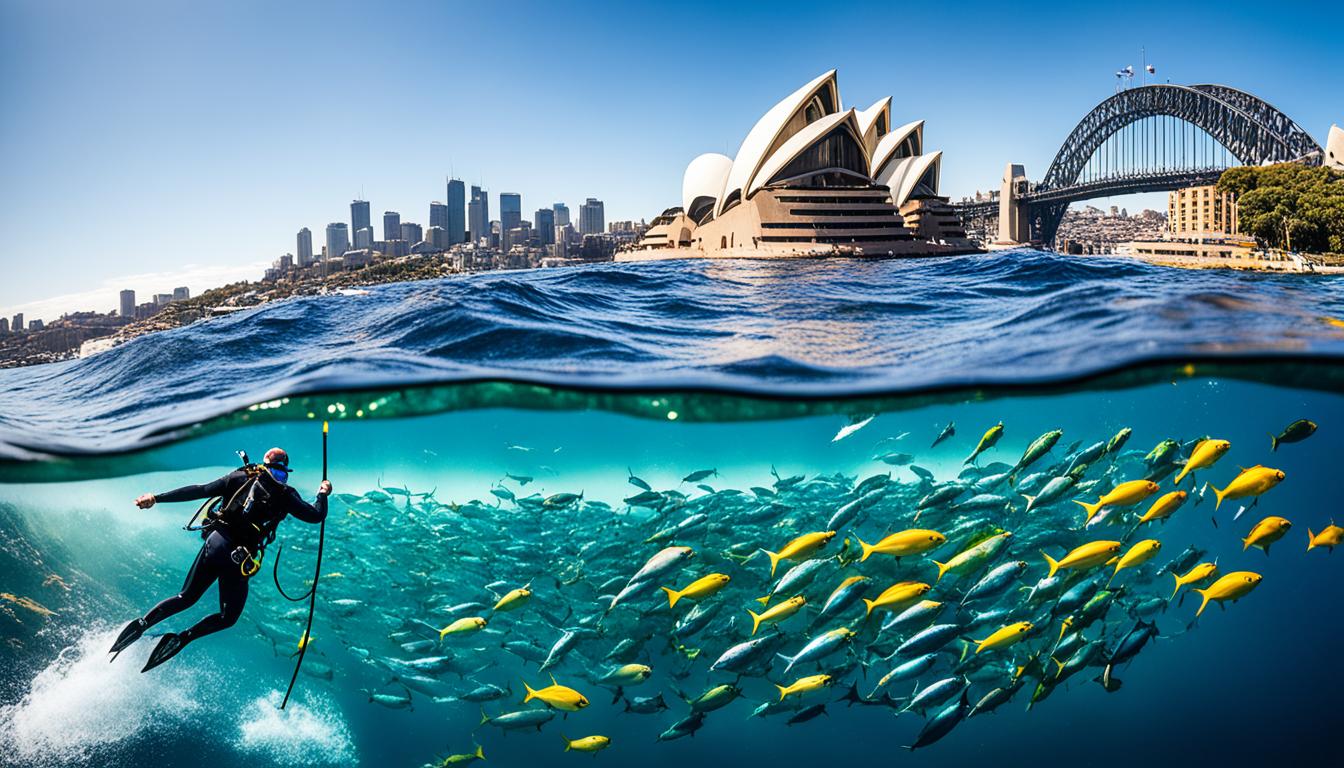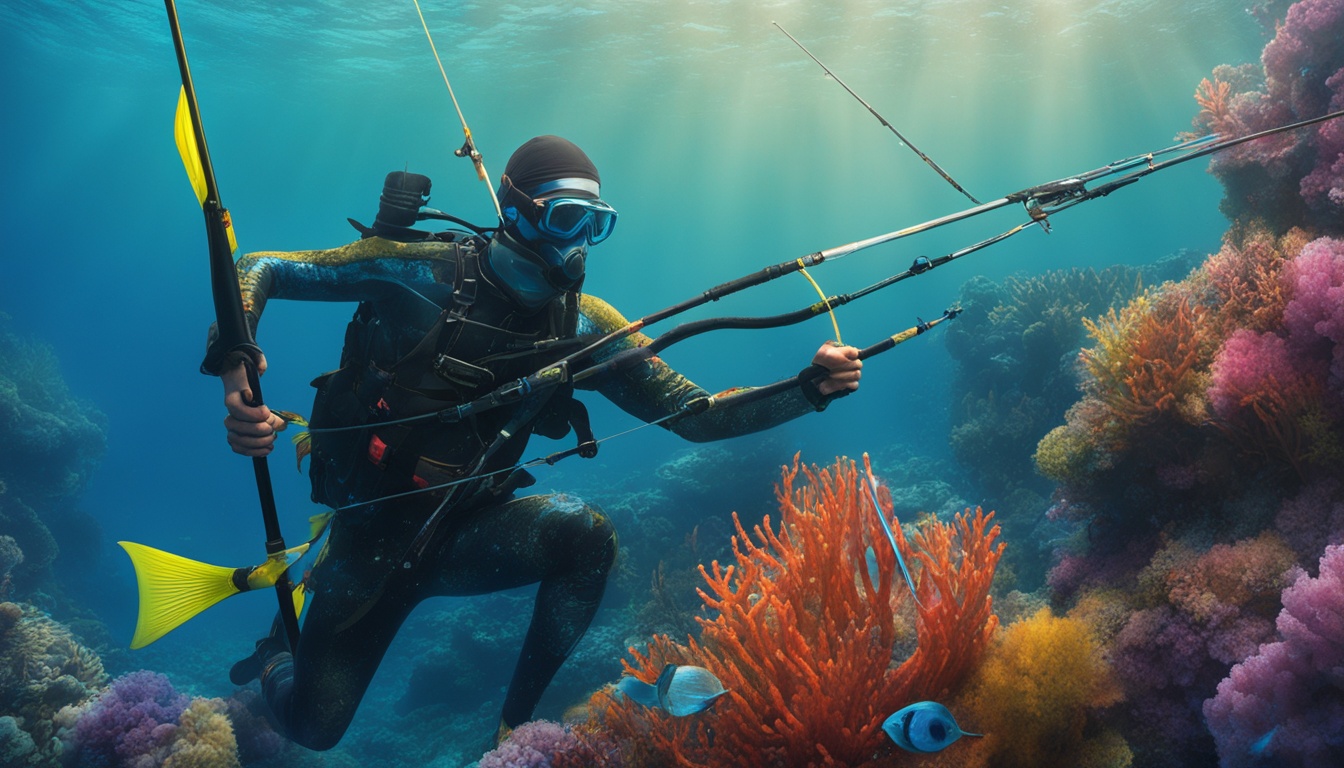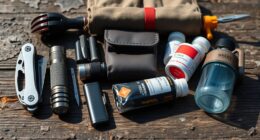A spearfishing weight belt is vital for achieving stability and control while you're beneath the waves. It helps you achieve neutral buoyancy, reducing energy expenditure and allowing for more effective movement. Start with weights around 10% of your body weight, adjusting as needed based on water conditions. Opt for materials that suit your style, like sturdy nylon or flexible rubber. Remember, a quick-release system is essential for safety. Regularly check your weight distribution and practice buoyancy checks to enhance your underwater confidence. Discover more tips and insights to maximize your spearfishing experience as you explore further!
Key Takeaways
- A weight belt is essential for achieving neutral buoyancy, enhancing stability and control while spearfishing underwater.
- Starting with 10% of your body weight in lead helps optimize buoyancy and energy efficiency during dives.
- Quick-release systems are crucial for safely dropping weights in emergency situations, boosting confidence in challenging conditions.
- Regularly assess weight distribution and engage in buoyancy checks to maintain optimal performance and stability underwater.
- Consider eco-friendly silicone weight belts for durability and reduced environmental impact without sacrificing comfort and performance.
Importance of Weight Belts
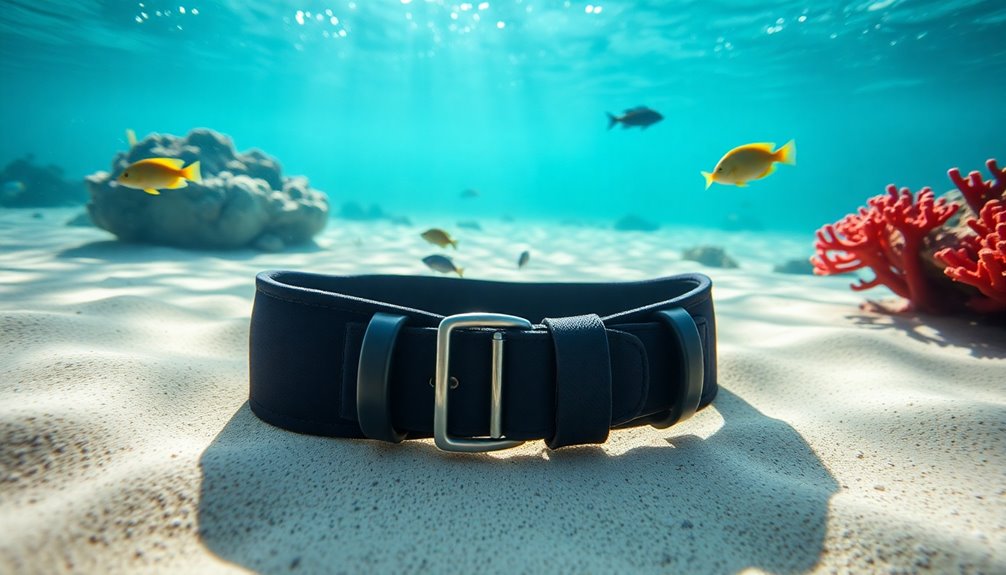
When you're diving, a weight belt is more than just an accessory; it's an indispensable component for achieving neutral buoyancy. This balance allows you to glide effortlessly through the water, considerably reducing energy expenditure while spearfishing.
Proper weight distribution provided by your weight belt enhances your stability and control, essential for effective movement and accurate targeting underwater.
Typically, the average starting weight for a weight belt in warm waters is around 10% of your body weight. However, adjustments may be necessary based on factors like wetsuit thickness and water salinity. It's important to find that sweet spot for ideal performance.
Safety is paramount, and quick-release systems on weight belts are critical. They allow you to drop weights rapidly in emergencies, preventing rapid ascents and minimizing associated risks.
Regular maintenance and checks on your weight belt are fundamental to verify it remains free from wear and corrosion. This vigilance not only promotes safety but also enhances your overall diving experience.
With a properly fitted weight belt, you’ll gain the confidence you need to explore the underwater world, improving your spearfishing adventures. In addition to the weight belt, having the right spearfishing equipment is crucial for a successful and safe dive. Quality gear such as a speargun, snorkel, mask, and wetsuit can make all the difference in the effectiveness of your spearfishing. By investing in proper equipment and honing your skills, you’ll be able to fully enjoy the thrill of spearfishing while also respecting the marine environment.
Selecting Your Weight Belt

Choosing the right weight belt is crucial for maximizing your spearfishing experience and guaranteeing safety underwater. Begin by considering the type of water you'll be diving in. Saltwater requires more weight due to increased buoyancy, so you'll need to adjust accordingly.
A good rule of thumb is to start with around 10% of your body weight in lead for warm waters, but this may vary based on your individual buoyancy needs and wetsuit thickness.
When it comes to material, you can choose between nylon belts and rubber belts. Nylon belts are sturdy and affordable, while rubber belts offer flexibility and a snug fit, catering to your comfort preference and diving style.
Confirm your weight belt includes a quick-release system, as this feature is crucial for safety, allowing for a rapid weight drop in emergencies.
Finally, regularly assess and adjust your weight distribution during practice dives at depths of 10-15 feet. This helps you fine-tune buoyancy, achieving ideal stability and control underwater.
Safety and Best Practices

Diving with safety in mind is essential for a successful spearfishing experience. Start by familiarizing yourself with the quick-release system on your weight belt. This feature is key for dropping weight during emergencies.
Before you dive, engage in thorough dive planning and assess water conditions to guarantee you're prepared for any challenges you might face.
Regular maintenance of your weight belt is important. Rinse it with fresh water after each dive to prevent corrosion and inspect it for any signs of wear and tear. This practice secures ongoing safety.
Additionally, utilize a dive buddy system; clear communication with your partner enhances safety and support, especially in unfamiliar waters.
Don't forget to practice buoyancy checks regularly. Make necessary weight adjustments based on your body composition and the environmental factors you encounter. This will optimize your stability and control while spearfishing.
Essential Spearfishing Gear

Having the right fundamental spearfishing gear can make all the difference in your underwater adventures. A weight belt is critical for achieving neutral buoyancy, allowing you to move effortlessly while focusing on your hunt. Proper weight distribution on your belt enhances stability and control, reducing drag and minimizing fatigue during longer underwater excursions.
When customizing your weight belt, start with lead weights that typically amount to around 10% of your body weight. Keep in mind that factors like wetsuit thickness and water salinity can affect this calculation.
It's essential to guarantee your belt is equipped with quick-release systems for safety; in emergencies, you need to drop those weights rapidly to avoid ascending too quickly.
Regular maintenance of your weight belt is fundamental for its reliability. Rinse it after each use to remove salt and debris, and check for any wear or damage. This simple upkeep guarantees your gear lasts longer and performs dependably during your spearfishing adventures.
Environmental Considerations
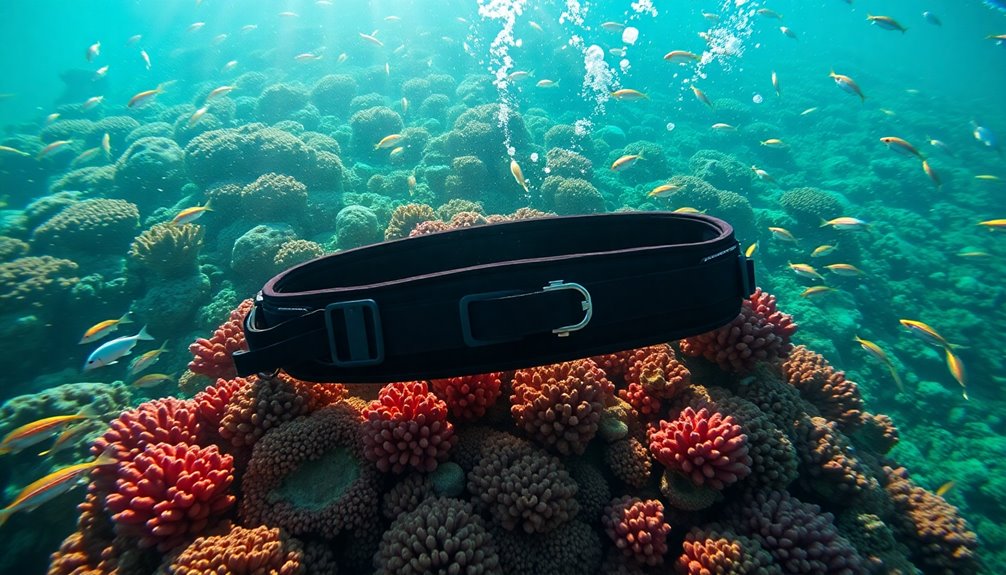
When it comes to spearfishing gear, environmental considerations are becoming increasingly important. By opting for silicone weight belts, you're making a choice that positively impacts the environment.
These belts boast superior UV radiation resistance and saltwater corrosion, promoting durability and longevity compared to traditional rubber options. This means you won't need to replace them as often, which considerably reduces waste and aligns with sustainable practices.
The production of silicone involves synthetic polymers that minimize ecological footprints, avoiding habitat destruction and resource exploitation.
Choosing silicone not only supports sustainability efforts but also enhances your performance and comfort while diving. With a slow degradation rate, silicone weight belts serve as a long-lasting alternative, proving their economic value over time.
Frequently Asked Questions
How Heavy Should My Weight Belt Be for Spearfishing?
When determining how heavy your weight belt should be for spearfishing, start with about 10% of your body weight in lead.
Adjust based on your wetsuit thickness and whether you're diving in saltwater or freshwater.
Remember, thicker wetsuits need more weight, and you might require additional weight for saltwater.
Practice at depths of 10-15 feet to fine-tune your buoyancy, ensuring you achieve neutral buoyancy for maximum control and efficiency underwater.
What Is the Most Important Feature of a Freediving Weight Belt?
When you dive, the thrill of exploring the depths contrasts sharply with the need for safety.
The most important feature of a freediving weight belt is its quick-release mechanism. This vital design allows you to drop weights instantly in emergencies, preventing rapid ascents that could lead to dangerous situations.
How Much Weight Do I Need on My Weight Belt?
To determine how much weight you need on your weight belt, start with about 10% of your body weight.
Adjust this based on your wetsuit's thickness and the water's salinity. A thicker wetsuit means you'll need more weight for neutral buoyancy.
It's wise to practice at depths of 10-15 feet to fine-tune your setup.
Remember to reassess your weight regularly as conditions change, ensuring safety and control while diving.
Is a Weight Belt Used to Counteract Buoyancy?
Oh sure, you could just float up like a balloon, but that wouldn't be much fun, would it?
A weight belt's your best friend when it comes to counteracting buoyancy. It helps you sink like a rock instead of bobbing around like a cork.
Conclusion
In the depths of the ocean, your weight belt isn't just a tool; it's your lifeline, balancing stability and freedom. While you glide beneath the waves, feeling the weight's embrace gives you the confidence to explore the underwater world. But remember, with great power comes great responsibility—always prioritize safety and respect the environment. So, strap on that belt, plunge in, and experience the exhilarating contrast of control and adventure that awaits beneath the surface!

